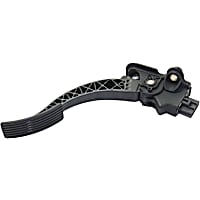The throttle position (TP) sensor is a device that helps the engine computer determine optimal ignition spark timing and fuel injection. It does this by determining how far open the throttle valve is. Vehicles with electronic throttle control (ETC) use two throttle position sensors as a fail-safe measure.
If the engine computer receives a signal from the TP sensor that exceeds the maximum limit for a set period, a P0123 code may get registered by on-board diagnostics.

What Does the P0123 Code Mean?
Diagnostic Trouble Code (DTC) P0123 code stands for “Throttle/Pedal Position Sensor “A” Circuit High.”
The throttle position (TP) sensor “A” is a potentiometer that is mounted on the throttle body and shaft that determines the throttle valve position. It monitors the throttle blade angle and relays this information to the throttle actuator module or powertrain control module (PCM).

A signal that exceeds a certain threshold for a specific amount of time will cause the PCM to log a throttle position sensor code.
It’s worth noting that vehicles with ETC also use a pair of accelerator pedal position (APP) sensors to measure how far the gas pedal is being depressed. On some vehicles, code P0123 may also be set if there’s a problem with the APP sensor, rather than the TP sensor.
If you’re planning to resolve P0123 yourself, you can find more useful information in our technical discussion about throttle position sensors.
Note: The definition of code P0123 may be different depending on the vehicle manufacturer. Consult the appropriate repair manual or repair database for the exact code definition.

What are the Possible Causes of the P0123 Code?
- Defective throttle position sensor
- Defective pedal position sensor
- Throttle/Pedal Position sensor circuit issues such as:
- Loose wiring or connections
- Circuit shorted to voltage
- TP sensor is not securely mounted
- Dirty or faulty throttle body
- PCM issues (e.g., software update is needed)
What are the Common Symptoms of the P0123 Code?
- Check engine light is illuminated
- Engine is hard starting or hesitating during acceleration (in some cases)
- Engine stalls or runs rough
How to Diagnose the P0123 Code
A DTC P0123 is a generic trouble code that may be logged in vehicles from different auto manufacturers. While these vehicles may exhibit similar triggers and symptoms, the steps for diagnosis and repair may vary between different makes and models.
If you’re not confident about conducting diagnostic tests on your vehicle, it’s a good idea to bring it to a professional mechanic. Otherwise, you may go ahead and diagnose the issue yourself. To help you get started, here are some videos that may give you an idea of what the process might involve:
How to Fix the P0123 Code
Attempting to fix a P0123 code may become a frustrating task if you don’t have the right tools and know-how to test the sensor circuit. In most cases, it’s best to leave the job to professionals.
For DIYers with advanced technical knowledge and hands-on experience who prefer to test and replace their TP sensor on their own, it will be helpful to rely on repair manuals. Guides like those from Chilton or an ALLDATA subscription provide vehicle-specific repair information.
Get Parts To Solve a Triggered P0123 Code
A faulty throttle position sensor can trigger a P0123 code and cause symptoms like a rough-running engine. This might seem minor, but you shouldn’t ignore this because it can snowball into more severe engine issues. Let CarParts.com help you get the right throttle position sensor quickly and at a great price.
Trust CarParts.com for high-quality throttle position sensors. Our sensors are sourced from only the most reputable aftermarket manufacturers in the industry. They’re precision-engineered to fit in your vehicle and restore it to tip-top shape. We also offer great value. Our parts are competitively priced so that you can fix your vehicle without breaking the bank.
Need a new throttle position sensor? Enjoy our low prices and shop for a new one here at CarParts.com!
Producrs Mentioned in this Guide
Any information provided on this Website is for informational purposes only and is not intended to replace consultation with a professional mechanic. The accuracy and timeliness of the information may change from the time of publication.


 Throttle Position Sensor
Throttle Position Sensor
 Accelerator Pedal Position Sensor
Accelerator Pedal Position Sensor


















